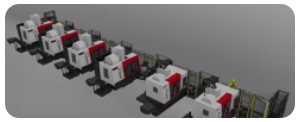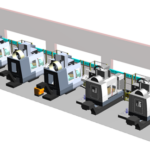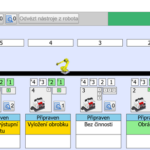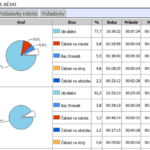The line consists of six milling centers and a robot that serves them. Part of the line is a tool storage and two input / output workstations – one for pallets and the other for replacing worn tools. The robot runs along the machines on the rail and provides the following:
– transport of palets with raw material and finished workpieces
– loading raw material into machines and unloading workpieces
– tool change in machines.
The main function of the COMES system is to control and synchronize the actions performed in the line. The COMES system communicates with the robot, machine tools and input stations. The system operates dynamically based on the distribution and handling of requirements that are continually being created at different line locations.
Communication with the operator is performed via touch terminals located at the input workplaces with pallets and tools. Terminals show operator requirements and current line status.
COMES functions
The following functions are also implemented in COMES:
- planning and executing production orders
- monitoring and reports on the number of manufactured products
- activity statistics, running machines and robots
- workpiece control statistics
- Andon display with current line status
Achieved Goals and Industry 4.0 Principles
The aim of the project was also to reduce the number of workers who would have to serve milling centers. The line can run alone and, for example, at night shift it is enough to serve 1 – 2 workers occasionally.
The line management philosophy is very close to new Industry 4.0 approaches, where production management is decentralized and the requirements are met by machines and equipment (I4.0 components) in production separately.
Video of the project
- Smart CNC production line with robot
- Status of CNC machines of smart line in COMES
- COMES statistics of CNC machines run





